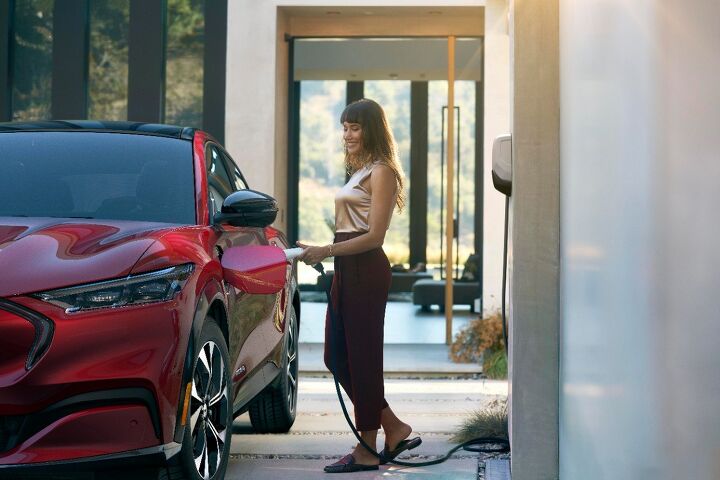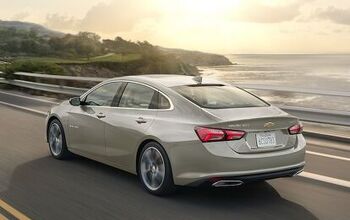BMW, Ford, Honda to Form New EV Charging Company

Ford, Honda, and BMW have announced plans to create a new “vehicle-to-grid company” that’s aimed at standardizing vehicle charging via a singular platform. The service also seeks to return excess energy to the electrical grid, effectively converting EVs into publicly shared batteries.
The business will be known as ChargeScape and, according to the automakers' press release, seeks to “create a single platform that will seamlessly connect electric utilities, automakers and their interested EV customers to manage energy usage for a broad pool of EVs.” The scheme could be one way of addressing concerns that modern power grids couldn’t endure widespread electric vehicle usage while helping to position the involved companies in an industry that’s being heavily incentivized by the government.
The company is still pending regulatory approvals, as we used to be concerned about corporate monopolies and are bound by tradition to pretend that still happens. Assuming ChargeScape is given the green light to move ahead, the trio plans to have equal shares and for the business to get rolling in 2024.
While EV charging companies owned by vehicle manufacturers are hardly new, ChargeScape is hoping to set itself apart by focusing on sharing the energy stored in their EV batteries with the electric grid — especially during periods of peak demand. Logistically, this would help soften the blow for public utilities hoping to deliver energy when demand surges throughout the day. But customers would also benefit by having the ability to sell back stored energy using a vehicle equipped with bidirectional charging capabilities which can be recouped at a lower price later on.
Though whether that theory plays out as advertised remains to be seen. Engineers have discussed the assumed need for localized energy storage as the demand for electricity grows and tapping into EVs could be a clever way of avoiding having to construct warehouse-sized battery hubs. This could likewise help circumvent some of the ecological issues associated with battery production and disposal by reducing the total number required to keep the energy grid functioning. But the premise of someone contentedly offloading battery range seems unlikely unless there’s a true financial incentive and customers feel absolutely certain there will be enough power left over for them when needed.
ChargeScape plans on addressing this by offering equipment that would help people manage energy sales during peak demand periods while also scheduling charging times during off-peak times. This could even be done by the company itself, rather than having customers set their own preferred schedules. Of course, this opens up the door to some of the unsavory aspects of smart home appliances that wrangle control away from the customer.
“Electric grid reliability and sustainability are the foundation for an EV powered future,” said Thomas Ruemenapp, Vice President, Engineering, BMW of North America. “ChargeScape aims to accelerate the expansion of smart charging and vehicle-to-everything solutions all over the country, while increasing customer benefits, supporting the stability of the grid and helping to maximize renewable energy usage. We’re proud to be a founding member of ChargeScape and are looking forward to the opportunities this collaboration will create.”
The companies are hoping to sell the concept as a way to help “decarbonize” the energy grid. ChargeScape will allegedly help “reduce EV customers’ personal carbon footprints” by utilizing electricity stemming from renewables like wind and solar. However, it’s not clear how that would work in parts of the country that are heavily reliant on other forms of energy production.
“Electric vehicles are unlocking entirely new benefits for customers that can save them money while supporting grid resiliency and increase the use of clean, renewable energy,” stated Bill Crider, global head of charging and energy services for the Ford Motor Company. “ChargeScape will help accelerate the true potential of the EV revolution by providing significant benefits to both utilities and EV customers through smart vehicle-to-grid services.”
You’ll notice a preponderance of buzz terms that have become commonplace within the automotive sector over the last decade. But the public seems more skeptical than ever these days, with some individuals now shying away whenever a business starts discussing smart devices, sustainability, stakeholders, and claims about de-carbonization.
“As Honda seeks to achieve our global goal of carbon neutrality, we are counting on this platform to create new value for our customers by connecting EVs to electric utilities, strengthening grid resources and reducing CO2 emissions,” suggested Jay Joseph, vice president of Sustainability and Business Development, American Honda Motor Co. “With automakers accelerating toward the electrified future, we must find solutions like ChargeScape that enable all stakeholders to work together for the good of our customers, society and our industry by enabling greater use of renewable energy for and from mobility.”
It’s your author’s assumption that the above companies have seen how well-positioned Tesla has managed to become by way of having its proprietary Supercharger network and want a piece of the pie. Nearly a dozen brands have already agreed to adopt Tesla’s charging standards and the company has since begun opening its network to vehicles not wearing its emblem.
Ford, Honda, and BMW anticipate leveraging the telematics procured by selling vehicles that tabulate and transmit massive amounts of information back to their data centers. While that should help ChargeScape function without Wi-Fi-connected charging stations, it could represent a rather massive conflict of interest.
Imagine if automakers also owned gas stations and enjoyed a steady stream of information about everything your vehicle was doing at all times, including exactly when, where, and how you were refueling. That’s effectively the direction this is all heading, just with fueling stations being replaced by EV charging points (including the one you’ve installed in your home). It seems like the above could qualify for antitrust enforcement. But your author is not qualified to provide legal advice and we seem to live in an era where corporate monopolies are relatively commonplace.
Whatever the future holds, the involved companies have expressed their desire to see the other automakers “join in and fully unlock opportunities provided by ChargeScape’s grid service offerings once the company is fully operational.”
[Image: Ford Motor Co.]
Become a TTAC insider. Get the latest news, features, TTAC takes, and everything else that gets to the truth about cars first by subscribing to our newsletter.

A staunch consumer advocate tracking industry trends and regulation. Before joining TTAC, Matt spent a decade working for marketing and research firms based in NYC. Clients included several of the world’s largest automakers, global tire brands, and aftermarket part suppliers. Dissatisfied with the corporate world and resentful of having to wear suits everyday, he pivoted to writing about cars. Since then, that man has become an ardent supporter of the right-to-repair movement, been interviewed on the auto industry by national radio broadcasts, driven more rental cars than anyone ever should, participated in amateur rallying events, and received the requisite minimum training as sanctioned by the SCCA. Handy with a wrench, Matt grew up surrounded by Detroit auto workers and managed to get a pizza delivery job before he was legally eligible. He later found himself driving box trucks through Manhattan, guaranteeing future sympathy for actual truckers. He continues to conduct research pertaining to the automotive sector as an independent contractor and has since moved back to his native Michigan, closer to where the cars are born. A contrarian, Matt claims to prefer understeer — stating that front and all-wheel drive vehicles cater best to his driving style.
More by Matt Posky
Latest Car Reviews
Read moreLatest Product Reviews
Read moreRecent Comments
- Jeanbaptiste 2022 Tesla model 3 performance ~35000 miles tires - ~$1000ish. Several cabin filters ~$50
- El scotto No rag-top, no rag-top(s) = not a prestigious car brand. Think it through. All of the high-end Germans and Lexus have rag-tops. Corvette is really its own brand.World-leading engines. AMG, M, S and well Lexus is third-world tough. GM makes one of the best V-8s in the world in Bowling Green. But nooooo, noooo, we're GM only Corvettes get Corvette engines. Balderdash! I say. Put Corvette engines in the top-tier Cadillacs. I know GM could make a world-class 3.5 liter V-6 but they don't or won't. In the interior everything that gets touched, including your butt, has to feel good. No exceptions.Some think that those who pay above MSRP and brag about it are idiots. Go the opposite direction, and offer an extended 10-year 100,000-mile factory warranty. At a reasonable price. That's Acura's current business model.
- Carrera 2014 Toyota Corolla with 192,000 miles bought new. Oil changes every 5,000 miles, 1 coolant flush, and a bunch of air filters and in cabin air filters, and wipers. On my 4th set of tires.Original brake pads ( manual transmission), original spark plugs. Nothing else...it's a Toyota. Did most of oil changes either free at Toyota or myself. Also 3 batteries.2022 Acura TLX A-Spec AWD 13,000 miles now but bought new.Two oil changes...2006 Hyundai Elantra gifted from a colleague with 318,000 when I got it, and 335,000 now. It needed some TLC. A set of cheap Chinese tires ($275), AC compressor, evaporator, expansion valve package ( $290) , two TYC headlights $120, one battery ( $95), two oil changes, air filters, Denso alternator ( $185), coolant, and labor for AC job ( $200).
- Mike-NB2 This is a mostly uninformed vote, but I'll go with the Mazda 3 too.I haven't driven a new Civic, so I can't say anything about it, but two weeks ago I had a 2023 Corolla as a rental. While I can understand why so many people buy these, I was surprised at how bad the CVT is. Many rentals I've driven have a CVT and while I know it has one and can tell, they aren't usually too bad. I'd never own a car with a CVT, but I can live with one as a rental. But the Corolla's CVT was terrible. It was like it screamed "CVT!" the whole time. On the highway with cruise control on, I could feel it adjusting to track the set speed. Passing on the highway (two-lane) was risky. The engine isn't under-powered, but the CVT makes it seem that way.A minor complaint is about the steering. It's waaaay over-assisted. At low speeds, it's like a 70s LTD with one-finger effort. Maybe that's deliberate though, given the Corolla's demographic.
- Mike-NB2 2019 Ranger - 30,000 miles / 50,000 km. Nothing but oil changes. Original tires are being replaced a week from Wednesday. (Not all that mileage is on the original A/S tires. I put dedicated winter rims/tires on it every winter.)2024 - Golf R - 1700 miles / 2800 km. Not really broken in yet. Nothing but gas in the tank.


































Comments
Join the conversation
having five diffetent suprcharger networks is TERRIBLE Business, and shows that people are HISTORICALLY ILLITERATE.
IF they KNEW the History of the US in the 19th century, they would know how DISASTROUS was the competition between rival railroads ALL of which would develop rails between A and B instead of JUST ONE DAMNED LINE for ALL of them.
Legendary Financier JP Morgan saved those morons from utter destruction by consolidating the industry and eliminating that DISASTROUS competition that produced HUGE REDUNDANCY and terrible losses to the idiots who did it.
I'm more interested in the brunette charging the fake Mustang.